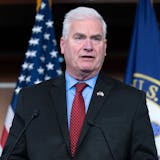In the coming weeks, leaves will fall, plants will shrivel, temperatures will sink and Americans will experience growing dread over the unpleasant experience that awaits us in November. No, not the presidential election — the end of daylight saving time.
Early on the day after Halloween, the nation will shift to what is inaccurately known as standard time, though it applies for only about four months of the year. The vast majority of us will have to reset clocks, adjust sleep times, endure mild symptoms of jet lag and get used to the sudden early onset of darkness. Then, in March, we will have to switch back in another round of disruption and aggravation.
It doesn't have to be this way. If there is anything we've learned from this routine, it's that we can structure and manipulate time to suit our needs. The clock, after all, is a human invention.
Within the U.S., daylight saving time has never won universal assent. Hawaii and Arizona don't use it, though it does apply on that chunk of Arizona reserved for the Navajo Nation. Indiana used to be a bizarre hodgepodge seemingly designed to drive residents and visitors to the brink of madness.
In 2006, the Associated Press noted, the state had "77 counties observing Eastern time but not changing clocks; five on Eastern time unofficially observing daylight-saving time; and 10 on Central time that observed daylight-saving time." There were a lot of missed appointments, late arrivals and panic attacks.
Florida Republican Sens. Marco Rubio and Rick Scott think the regular switch-overs are not worth the trouble. They've introduced a bill, the Sunshine Protection Act, to make daylight saving time permanent everywhere year-round. The Florida legislature is one of a dozen that have passed legislation to use it year-round, but federal law forbids any state from doing so.
Their measure would not literally protect sunshine, which will be present for the same interval every 24 hours regardless of what your clock says. Nor would it "save" daylight; it would merely shift it, in effect, from one time of day to another.
Daylight saving time was made year-round in 1974, during the energy crisis, to reduce gasoline consumption, which it apparently did. But the experiment was scrapped because it appeared to increase the number of kids being hit by cars on their way to school.

